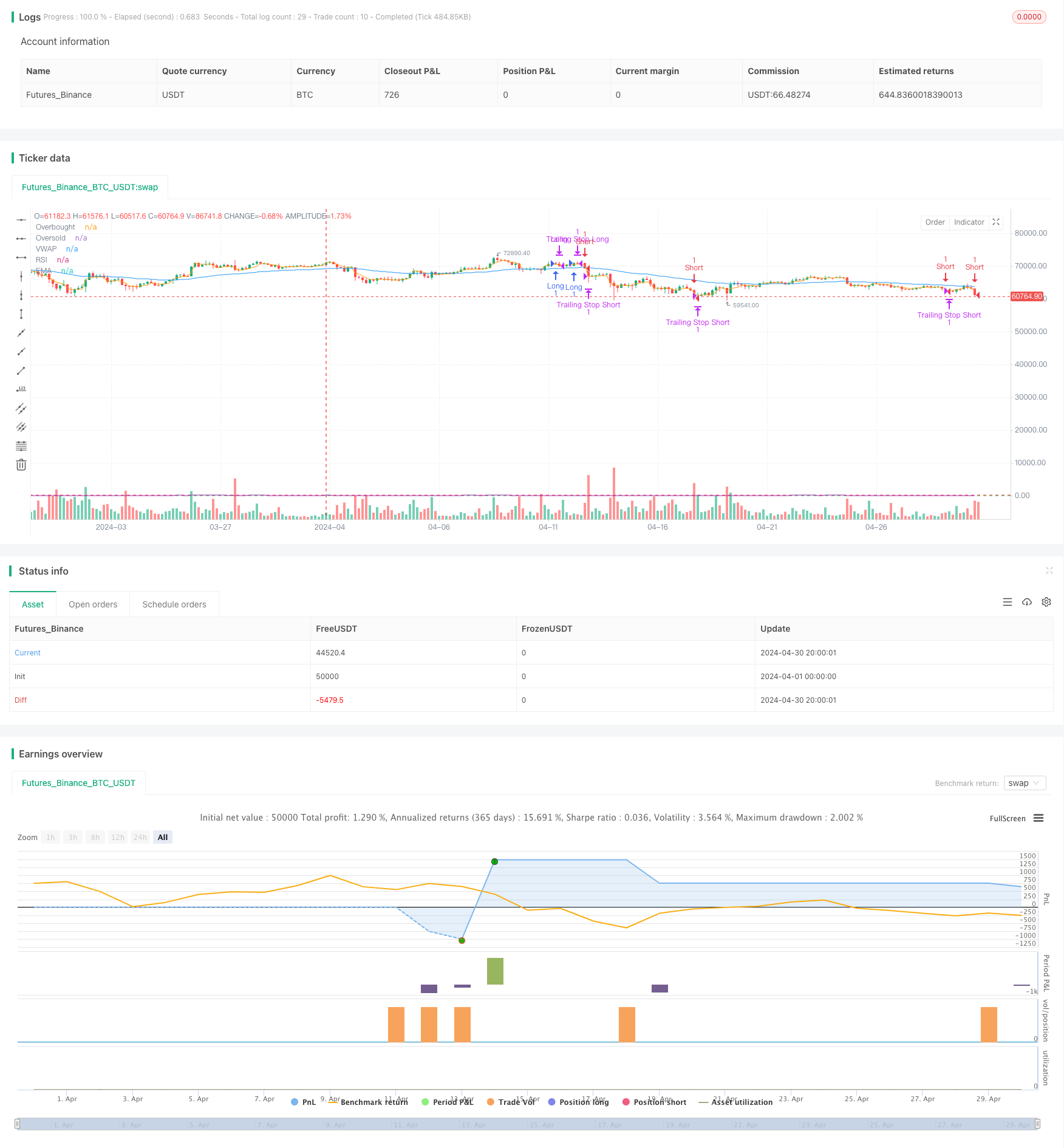动态趋势动量交易策略
Author: ChaoZhang, Date: 2024-05-23 17:57:22Tags: EMAMACDVWAPRSI

概述
该策略结合了EMA、MACD、VWAP和RSI等多个指标,旨在捕捉高概率的交易机会。策略使用EMA来判断趋势方向,MACD来判断动量,VWAP来判断成交量,RSI来判断超买超卖情况。策略根据这些指标的组合来产生买入和卖出信号,同时使用移动止损来保护利润。
策略原理
- 使用EMA来判断趋势方向,当价格在EMA上方时认为是上升趋势,在EMA下方时认为是下降趋势。
- 使用MACD来判断动量,当MACD快线上穿慢线时认为动量转强,快线下穿慢线时认为动量转弱。
- 使用VWAP来判断成交量,当价格在VWAP上方时认为买盘强于卖盘,在VWAP下方时认为卖盘强于买盘。
- 使用RSI来判断超买超卖情况,当RSI高于70时认为超买,低于30时认为超卖。
- 当价格在EMA上方,MACD快线上穿慢线,价格在VWAP上方,RSI低于超买水平时,产生买入信号。
- 当价格在EMA下方,MACD快线下穿慢线,价格在VWAP下方,RSI高于超卖水平时,产生卖出信号。
- 根据账户资金和风险比例来计算头寸大小。
- 使用移动止损来保护利润,止损价格随着价格变动而变动。
策略优势
- 多指标组合使用,可以更全面地判断市场状态,提高交易信号的准确性。
- 使用移动止损,可以在趋势延续时保护利润,减少回撤。
- 根据账户资金和风险比例来计算头寸大小,可以控制每笔交易的风险。
- 参数可以根据用户偏好进行调整,提高策略的灵活性。
策略风险
- 在震荡市场中,频繁的交易信号可能导致过度交易和手续费损失。
- 在趋势反转时,移动止损可能无法及时止损,导致较大的回撤。
- 参数的选择需要根据不同市场和品种进行优化,不恰当的参数可能导致策略表现不佳。
策略优化方向
- 可以考虑加入更多的过滤条件,如交易量、波动率等,以进一步提高信号的准确性。
- 可以考虑使用更加动态的止损方式,如ATR止损等,以更好地应对不同的市场状况。
- 可以考虑对参数进行优化,如使用遗传算法等方法,寻找最优参数组合。
- 可以考虑加入仓位管理和资金管理策略,以更好地控制风险和提高收益。
总结
该策略通过结合多个指标来判断市场状态,产生交易信号,同时使用移动止损来保护利润。策略参数可以根据用户偏好进行调整,提高策略的灵活性。但是,策略在震荡市场中可能表现不佳,在趋势反转时可能面临较大回撤,因此需要根据不同市场和品种进行优化和改进。未来可以考虑加入更多的过滤条件、动态止损方式、参数优化和仓位管理等方面的优化,以提高策略的稳定性和盈利能力。
/*backtest
start: 2024-04-01 00:00:00
end: 2024-04-30 23:59:59
period: 4h
basePeriod: 15m
exchanges: [{"eid":"Futures_Binance","currency":"BTC_USDT"}]
*/
//@version=5
strategy("Intraday Strategy", overlay=true)
// Input parameters
emaLength = input.int(50, title="EMA Length")
macdShort = input.int(12, title="MACD Short Period")
macdLong = input.int(26, title="MACD Long Period")
macdSignal = input.int(9, title="MACD Signal Period")
rsiLength = input.int(14, title="RSI Length")
rsiOverbought = input.int(70, title="RSI Overbought Level")
rsiOversold = input.int(30, title="RSI Oversold Level")
risk = input.float(1, title="Risk Percentage", minval=0.1, step=0.1)
trailOffset = input.float(0.5, title="Trailing Stop Offset", minval=0.1, step=0.1)
// Calculating indicators
ema = ta.ema(close, emaLength)
[macdLine, signalLine, _] = ta.macd(close, macdShort, macdLong, macdSignal)
rsi = ta.rsi(close, rsiLength)
vwap = ta.vwap(close)
// Entry conditions
longCondition = ta.crossover(macdLine, signalLine) and close > ema and rsi < rsiOverbought and close > vwap
shortCondition = ta.crossunder(macdLine, signalLine) and close < ema and rsi > rsiOversold and close < vwap
// Exit conditions
longExitCondition = ta.crossunder(macdLine, signalLine) or close < ema
shortExitCondition = ta.crossover(macdLine, signalLine) or close > ema
// Position sizing based on risk percentage
capital = strategy.equity
positionSize = (capital * (risk / 100)) / close
// Executing trades
if (longCondition)
strategy.entry("Long", strategy.long, qty=1)
if (shortCondition)
strategy.entry("Short", strategy.short, qty=1)
if (longExitCondition)
strategy.close("Long")
if (shortExitCondition)
strategy.close("Short")
// Trailing stop loss
if (strategy.position_size > 0)
strategy.exit("Trailing Stop Long", from_entry="Long", trail_price=close, trail_offset=trailOffset)
if (strategy.position_size < 0)
strategy.exit("Trailing Stop Short", from_entry="Short", trail_price=close, trail_offset=trailOffset)
// Plotting indicators
plot(ema, title="EMA", color=color.blue)
hline(rsiOverbought, "Overbought", color=color.red)
hline(rsiOversold, "Oversold", color=color.green)
plot(rsi, title="RSI", color=color.purple)
plot(vwap, title="VWAP", color=color.orange)
相关内容
- 多指标趋势跟踪期权交易EMA交叉策略
- 多指标组合的高频交易策略:指数均线与动量指标相结合的短线交易系统
- EMA交叉与RSI过滤的双重趋势策略
- 趋势波段交易EMA-MACD复合策略
- EMA RSI MACD动态止盈止损交易策略
- 基于多重技术指标的趋势跟踪与动量策略
- EMA、MACD、RSI三重指标动量策略
- 多级平衡量化交易策略
- EMA动态止损交易策略
- 复合技术指标多维度趋势跟踪量化策略
更多内容
- MOST指标双仓位自适应策略
- 布林带RSI交易策略
- 基于成交量热图与实时价格的买卖策略
- 双均线回归交易策略
- 多指标量化交易策略 - 7合1超级指标策略
- SMK ULTRA TREND 双均线交叉策略
- 五重强势移动平均策略
- 均线交叉牛市支撑带策略
- 多时间框架与200EMA过滤器的趋势跟踪策略 - 仅做多
- SMC市场高低点突破策略
- EMA均线交叉与短期信号策略
- 一目云和ATR策略
- BONK多因子交易策略
- 双均线交叉策略
- HalfTrend多空趋势追踪止损限价买入策略
- Alligator 长期趋势跟踪交易策略
- 基于脉冲MACD和双均线交叉的多时间尺度趋势追踪策略
- EMA5与EMA13交叉策略
- EMA SAR 中长期趋势跟踪策略
- 逆向波动率突破策略